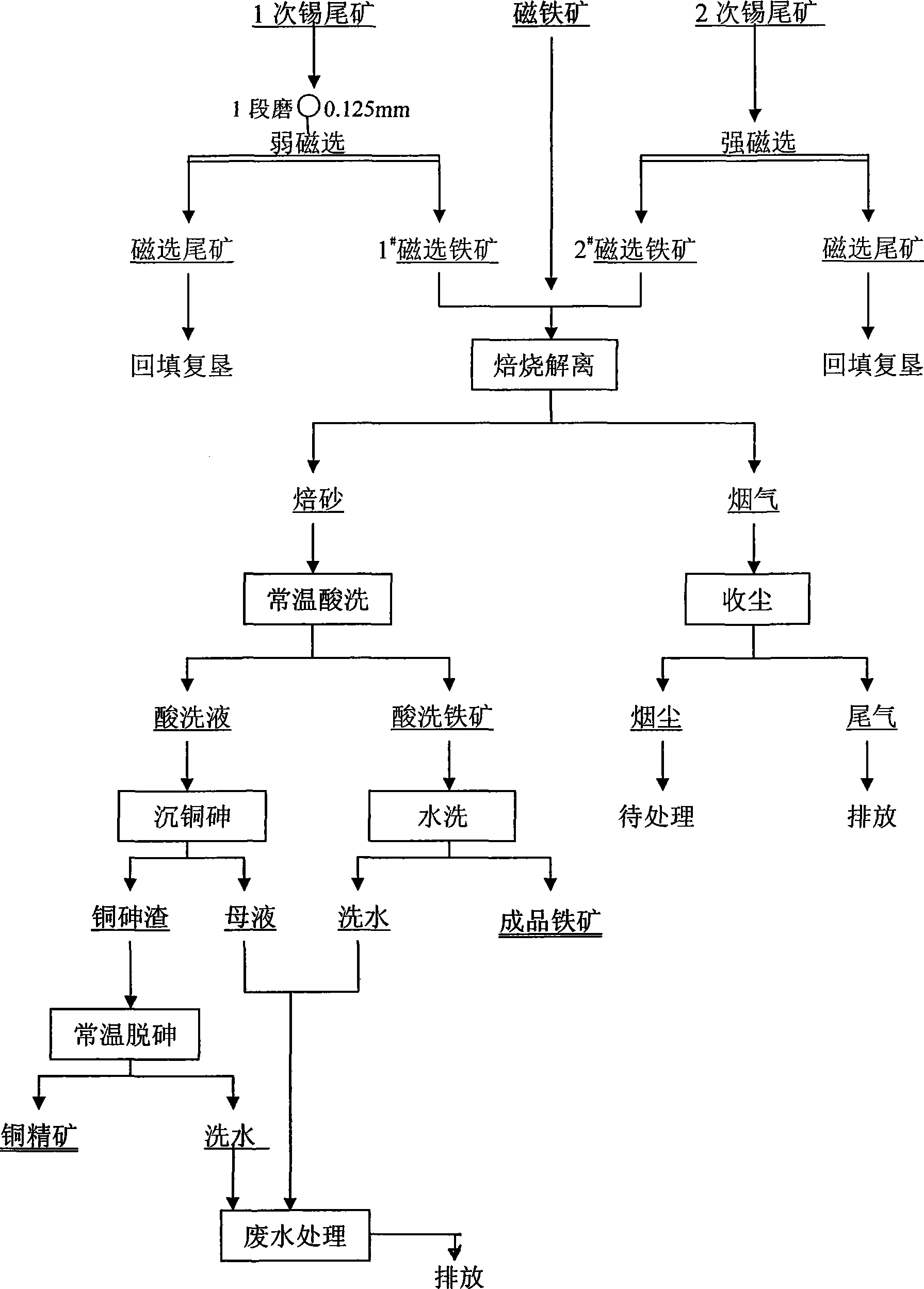Method for producing iron ore concentrate by using poor-tin oxidized ore tailings
A technology of oxidized ore and iron concentrate, applied in the direction of chemical instruments and methods, improvement of process efficiency, magnetic separation, etc., can solve the problems of inability to deal with polymetallic ore tailings, etc., and achieve easy industrial implementation, energy saving and consumption reduction Effect
- Summary
- Abstract
- Description
- Claims
- Application Information
AI Technical Summary
Problems solved by technology
Method used
Image
Examples
Embodiment 1
[0030] Example 1: Raw material primary tailings main chemical composition mass percent (mass%): Fe 36.0, Cu 0.39, Pb0.45, Zn 0.50, Sn 0.16, S 0.115, P 0.03, As 1.98
[0031] (1) Dehydrating the raw material to less than 6% by mass, and grinding to a pulverized material with a particle size of less than 0.125mm.
[0032] (2) The pulverized material is subjected to 1-stage wet weak magnetic separation with a magnetic separator with a magnetic field strength of 1200-1600 Gauss to obtain No. 1 magnetically separated iron ore. The yield is 29.21%, the iron grade is 48.44%, and the direct recovery rate of metallic iron is 45.01%. Calculated by the difference, the magnetic separation tailings contain 29.68% iron.
[0033] (3) No. 1 magnetically separated iron ore is dried at 105°C until the water content accounts for less than 6% of the raw material. In a box-type resistance furnace, at a temperature of 930-960°C, air is used as an oxidant for oxidative roasting and dissociation. Th...
Embodiment 2
[0035] Example 2: Raw material secondary tailings main chemical composition mass percentage (mass %):: Fe 33.3, Cu 0.29, Pb 0.53, Zn 0.39, Sn 0.12, S 0.10, As 1.44;
[0036] (1) drying the raw material in the sun until the water content is below 6% by mass, and crushing to a pulverized material with a particle size of less than 0.125mm;
[0037] (2) Use a magnetic separator with a magnetic field strength of 8,000 to 10,000 gauss to carry out 1-stage dry strong magnetic separation to obtain No. 2 magnetic-separated iron ore with a yield of 42.86% and a magnetic-separated iron ore with an iron grade of 47.80% containing 1.45% As ; Metal iron beneficiation direct recovery rate of 61.43%. Calculated by the difference, the tailings contain 22.48% Fe.
[0038] (3) Take No. 2 magnetically separated iron ore, roast and dissociate at a temperature of 860° C. for 1.5 hours, the air volume is metered and supplied with 1200-1400 L / kg material, and the calcined sand is produced with a yie...
Embodiment 3
[0040] Embodiment 3: lead-arsenic magnetite in the raw material, main chemical composition mass percent (%): Fe 56.46, Cu 0.24, Pb 1.03, Zn 1.01, Sn 0.14, S 0.063, P 0.188, As 0.54. Particle size≤1mm.
[0041] (1) The raw material magnetite is roasted and dissociated at a temperature of 760°C for 1.5 hours, and the air volume is metered and supplied at 1300-1500L / kg·material to produce calcined sand with a yield of 92.65%.
[0042] (2) Slurry the calcined sand with water, stir and wash it with industrial hydrochloric acid at room temperature for 1.5 hours, the amount of acid is measured according to the mass ratio of calcined sand to hydrochloric acid 100:9.8, the pH of the solution at the end point is ≤ 1.0, and the acid-washed iron ore is rinsed with tap water Until the eluate is neutral and dried to obtain iron concentrate, the composition is (%): Fe 61.56, S 0.064, P 0.16, Pb 0.14, As 0.089. The yield of iron concentrate is 89.42%, and the iron recovery rate is 97.50%.
PUM
| Property | Measurement | Unit |
|---|---|---|
| particle size | aaaaa | aaaaa |
| particle size | aaaaa | aaaaa |
Abstract
Description
Claims
Application Information
 Login to View More
Login to View More - R&D
- Intellectual Property
- Life Sciences
- Materials
- Tech Scout
- Unparalleled Data Quality
- Higher Quality Content
- 60% Fewer Hallucinations
Browse by: Latest US Patents, China's latest patents, Technical Efficacy Thesaurus, Application Domain, Technology Topic, Popular Technical Reports.
© 2025 PatSnap. All rights reserved.Legal|Privacy policy|Modern Slavery Act Transparency Statement|Sitemap|About US| Contact US: help@patsnap.com


